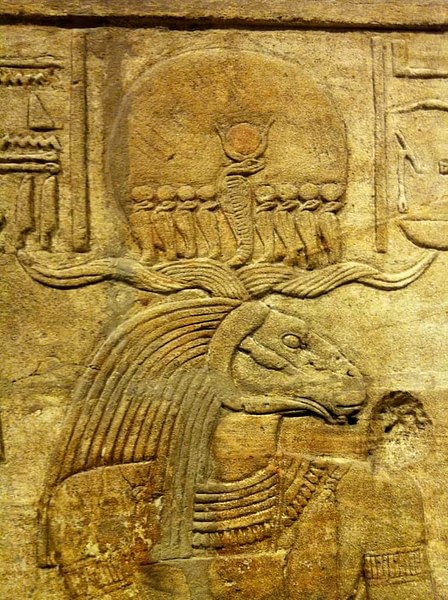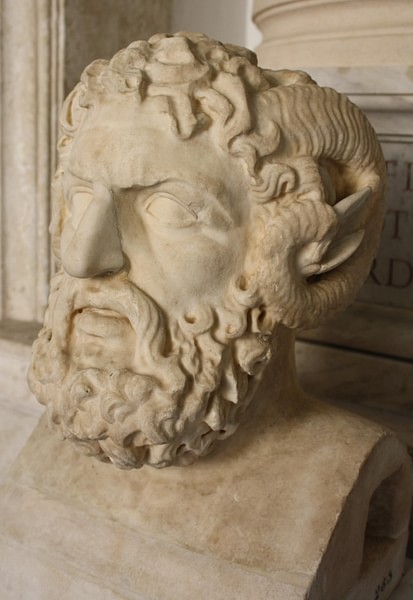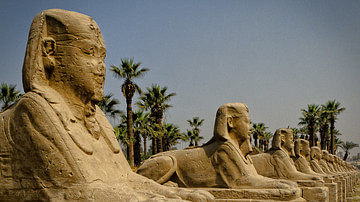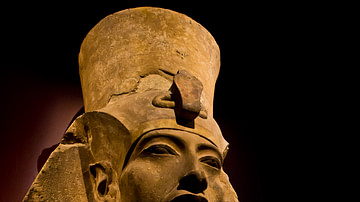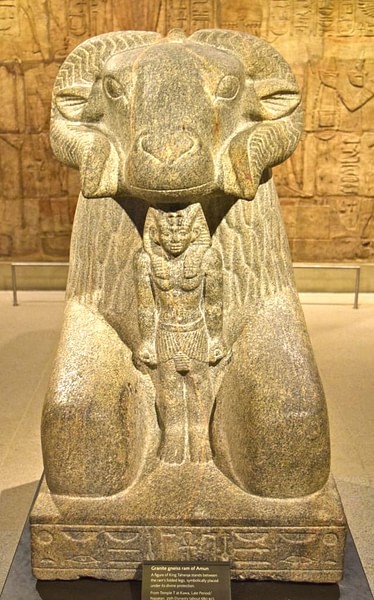
Amun (also Amon, Ammon, Amen, Amun-Ra) is the ancient Egyptian god of the sun and air. He is one of the most important gods of ancient Egypt who rose to prominence at Thebes at the beginning of the period of the New Kingdom (c. 1570-1069 BCE). His cult was the most powerful and popular in Egypt for centuries.
He is usually depicted as a bearded man wearing a headdress with a double plume or, after the New Kingdom, as a ram-headed man or simply a ram, symbolizing fertility in his role as Amun-Min. His name means "the hidden one," "invisible," "mysterious of form," and unlike most other Egyptian gods, he was considered Lord of All who encompassed every aspect of creation.
Origin & Rise to Prominence
Amun is first mentioned in the Pyramid Texts (c. 2400-2300 BCE) as a local god of Thebes along with his consort Amaunet. At this time, the supreme god of Thebes was the war god Montu and the creator god was regarded as Atum (also known as Ra). Montu was a fierce warrior who protected the city and helped it expand while Atum was the supremely powerful, self-created deity who arose on the primordial mound from the waters of chaos at the beginning of creation. Amun, at this time, was associated with protecting the king but, largely, was simply a local fertility god paired with his consort Amaunet as part of the Ogdoad, eight gods who represented the primordial elements of creation.
Amun was considered no more powerful or significant than the other gods who were part of the Ogdoad but represented the element of "hiddenness" or "obscurity" while the others represented more clearly defined concepts such as "darkness," "water," and "infinity." Amun as "The Obscure One" left room for people to define him according to their own understanding of what they needed him to be. A god who represented darkness could not also represent light, nor a god of water stand for dryness, etc. A god who personified the mysterious hidden nature of existence, however, could lend himself to any aspect of that existence; and this is precisely what happened with Amun. 
Around c. 1800 BCE the Hyksos, a mysterious people most likely from the Levant, settled in Egypt, and by c. 1720 BCE they had grown powerful enough to take control of Lower Egypt and render the court at Thebes obsolete. This era is known as The Second Intermediate Period (c. 1782 - c. 1570 BCE) in which the Hyksos ruled Egypt. C. 1570 BCE the prince Ahmose I (c. 1550 - c. 1525 BCE) drove the Hyksos out of the country and re-established the city of Thebes.
Since the time of the Middle Kingdom (2040-1782 BCE) Amun had been growing in power in Thebes and was a part of the Theban triad of deities with his consort Mut (who replaced Amaunet) and their son Khonsu, the moon god. When Ahmose I defeated the Hyksos he attributed his victory to Amun linking him to the well-known sun god Ra. As Amun was "The Hidden One" linked to no definable natural phenomenon or principle, he was malleable enough to fit with any attribute one wished to add to him. In this case, the mysterious aspect of life - that which makes life what it is - was linked to the visible life-giving aspect of existence: the sun. Amun then became Amun-Ra, creator of the universe, and King of the Gods.
King of the Gods
Following Amun's ascendancy during the New Kingdom, he was hailed as "The Self-created One" and "King of the Gods" who had created all things, including himself. He was associated with the sun god Ra who was associated with the earlier god Atum of Heliopolis. Although Amun took on many of Atum's attributes and more or less replaced him, the two remained distinct deities and Atum continued to be venerated. In his role as Amun-Ra, the god combines his invisible aspect (symbolized by the wind which one cannot see but is aware of) and his visible aspect as the life-giving sun. In Amun, the most important aspects of both Ra and Atum were combined to establish an all-encompassing deity whose aspects were literally every facet of creation.
His cult was so popular that, as scholar Richard H. Wilkinson observes, Egyptian religion became almost monotheistic and Amun "came particularly close to being a kind of monotheistic deity" (94). The popularity of this god, in fact, ushered in the first monotheistic religious movement in Egypt under Akhenaten (1353-1336 BCE) who banned polytheistic worship and established the state religion of the one true god Aten.
Although Akhenaten's efforts have historically been viewed as a sincere effort at religious reform, he was most likely motivated by the great wealth of the Priests of Amun, who, at the time he ascended to the throne, held more land and greater wealth than the pharaoh.
Significance & Cult
Once Amun was identified as the most powerful deity in the universe he acquired epithets which described his various aspects as best they could. Wilkinson writes how "the Egyptians themselves called him Amun asha renu or 'Amun rich in names,' and the god can only be fully understood in terms of the many aspects which were combined in him" (92). He was known as "The Concealed God" - he whose nature could not be known and associated with air or the wind which can be felt but not seen or touched. He was also the Creator God who originally stood on the first dry ground at the beginning of time and created the world by mating with himself.
Once he was linked with Ra to become Amun-Ra, he took on Ra's aspects as a solar god and, as one would expect from a creator, was also a fertility god linked with the fertility deity Min (a very ancient god) and known in this regard as Amun-Min. As he had absorbed the attributes of the war god Montu of Thebes, he was regularly invoked in battle (as Ahmose I had done) and so was also a war god. His mysterious nature infused and gave form to all that human beings could see and all that remained hidden from sight and so he was also a universal god, the most powerful in the universe and, naturally, the King of the Gods. Egyptologist Geraldine Pinch writes:
In his chief cult temple at Karnak in Thebes, Amun, Lord of the Thrones of the Two Lands, ruled as a divine pharaoh. Unlike other important deities, Amun does not seem to have been thought of as living in some distant celestial realm. His presence was everywhere, unseen but felt like the wind. His oracles communicated the divine will to humanity. Amun was said to come swiftly to help Egyptian kings on the battle field or to aid the poor and friendless. When he was manifest in his cult statues, Amun periodically visited the necropolis of Thebes to unite with its goddess, Hathor, and bring new life to the dead. (100-101)
Amun in the New Kingdom rapidly became the most popular and most widely venerated deity in Egypt. Wilkinson notes that "the monuments which were built to him at that time were little short of astounding and Amun was worshipped in many temples throughout Egypt" (95). The main Temple of Amun at Karnak is still the largest religious structure ever built and was connected to the Southern Sanctuary of the Luxor Temple. The ruins of these temples and many others to Amun may still be seen today but there was also a floating temple at Thebes known as Amun's Barque which was said to be among the most impressive works created for the god.
Amun's Barque was known to the Egyptians as Userhetamon, "Mighty of Brow is Amun," and was a gift to the city from Ahmose I following his victory over the Hyksos and ascension to the throne. Egyptologist Margaret Bunson writes, "It was covered in gold from the waterline up and was filled with cabins, obelisks, niches, and elaborate adornments" (21). On Amun's great festival, The Feast of Opet, the barque would move with great ceremony - carrying Amun's statue from the Karnak temple downriver to the Luxor temple so the god could visit. During the festival of The Beautiful Feast of the Valley, which honored the dead, the statues of Amun, Mut, and Khonsu (the Theban Triad) traveled on the ship from one side of the Nile to the other in order to participate.
On other days the barque would be docked on the banks of the Nile or at Karnak's sacred lake. When not in use, the ship would be housed in a special temple at Thebes built to its specifications, and every year the floating temple would be refurbished and repainted or rebuilt. Other barques of Amun were built elsewhere in Egypt, and there were other floating temples to other deities, but Amun's Barque of Thebes was said to be especially impressive.
The Priests of Amun & Pharaoh Akhenaten
The kind of wealth King Ahmose I had at his command to enable him to build the elaborate barque for Amun would eventually appear minuscule when compared to the riches amassed by the priests of Amun at Thebes and elsewhere. By the time of Amenhotep III (1386-1353 BCE), the priests owned more land, had more cash on hand, and were almost as powerful as the pharaoh. Amenhotep III introduced religious reforms in an attempt to curb the power of the priesthood, but they were fairly ineffective.
His most significant reform was the elevation of a formerly minor deity, Aten, to his personal patron and encouraged the worship of this god alongside Amun. The cult of Amun was unaffected by this, however, and continued to grow. Aten was already associated with Amun and with Ra as the solar disc representative of the sun's divine power. The symbol of Aten simply became another way in which to express one's devotion to Amun, and the priests continued to live their comfortable lives of privilege and power.
This situation changed dramatically when Amenhotep IV (1353-1336 BCE) succeeded his father as pharaoh. For the first five years of his reign Amenhotep IV followed the policies and practices of his father but then changed his name to Akhenaten (meaning "successful for" or "of great use to" the god Aten) and initiated dramatic religious reforms which affected every aspect of life in Egypt. Religious life was intimately tied to one's daily existence and the gods were a part of one's work, one's family, and one's leisure activities.
The people relied on the temples of the gods not just as a source of spiritual comfort and security but as places of employment, food depots, doctor's offices, counseling centers, and shopping centers. Akhenaten closed the temples and forbade the traditional worship of the gods of Egypt; he proclaimed Aten the one true god and the only deity worthy of veneration.
He had a new city built, Akhetaten, and abandoned Thebes as his capital. Historian Marc van de Mieroop comments on this, writing:
With the move to Akhetaten, Akhenaten no longer just ignored the other gods of Egypt, but started to persecute them, especially Amun, whose name and images he had removed...many people continued their previous religious practices in private although no official cults but Aten's were tolerated. (203)
When Akhenaten died in 1336 BCE, his son Tutankhaten took the throne, changed his name to Tutankhamun (1336-1327 BCE), and moved the capital of Egypt back to Thebes. He reinstated the old Egyptian religion and opened all the temples. On his death, the general Horemheb (1320-1292 BCE) ruled as pharaoh (after a brief power struggle) and obliterated the memory of Akhenaten and his family from the historical record as he raised the old gods to their former heights. The power of the Aten cult and Akhenaten's religious movement seems to have continued, however, and it has been suggested that the great Hebrew law-giver Moses was a priest of Aten who left Egypt with his followers to establish a monotheistic community elsewhere. This theory is explored in depth in Sigmund Freud's work Moses and Monotheism.
The Continued Popularity of Amun
After the reign of Horemheb, Amun's cult continued on as it had before and was just as popular. It gained widespread acceptance throughout the 19th Dynasty of the New Kingdom and, by the time of the Ramessid Period (c. 1186-1077 BCE) the priests of Amun were so powerful they were able to rule Upper Egypt from Thebes as pharaohs. The power of the priests of Amun, in fact, is a major factor in the fall of the New Kingdom. The Cult of Amun continued to exercise control from Thebes during the Third Intermediate Period (c. 1069-525 BCE) even as the Cult of Isis gained more followers.
A custom elevated by Ahmose I was the consecration of royal women as "divine wives of Amun" who would officiate at festivals and ceremonies. This position existed prior to Ahmose I but he turned the office of God's Wife of Amun into one of great prestige and power. This position was given even greater importance later and, Wilkinson writes, "the Kushite kings of the 25th dynasty continued this practice and their rule actually led to a resurgence in the worship of Amun as the Nubians had accepted the god as their own" (97). When the Assyrian king Ashurbanipal sacked Thebes in 666 BCE Amun was worshiped widely throughout Egypt, and afterwards, the god remained just as popular. Wilkinson notes,
The worship of Amun also extended to the non-formal veneration of popular religion. The god was regarded as an advocate of the common man, being called "the vizier of the humble" and "he who comes at the voice of the poor" and as "Amun of the Road" he was also regarded as the protector of travellers. (97)
Queen Hatshepsut (1479-1458 BCE) had once claimed Amun was her father and thereby legitimized her reign. Alexander the Great would do the same in 331 BCE at the Siwa Oasis, proclaiming himself a son of the god Zeus-Ammon, the Greek version of the god. In Greece, Zeus-Ammon was depicted as the full-bearded Zeus with the ram's horns of Amun and associated with power and virility through imagery including the bull and the ram. The god was taken to Rome as Jupiter-Ammon where he was venerated for the same reasons as elsewhere.
Amun's popularity declined overall in Egypt as Isis became more popular, but he was still worshiped regularly at Thebes even after the city fell into ruin following the Assyrian invasion. His cult took hold especially in the region of the Sudan where, as in Egypt, his priests became powerful and wealthy enough to enforce their will on the kings of Meroe. As in the Amarna Period of Egypt's history, when Akhenaten moved against the priests of Amun, King Ergamenes of Meroe could no longer tolerate the power of the priests of Amun in his country and had them massacred c. 285 BCE, thereby breaking ties with Egypt and establishing an autonomous state.
Amun continued to be revered in Meroe and elsewhere, however, as a potent deity. The cult of Amun would continue to attract followers well into the period known as classical antiquity (c. 5th century CE) when, like all the old gods, he was eclipsed by the new religion of Christianity.
